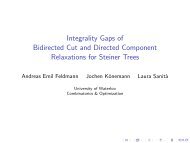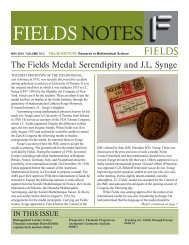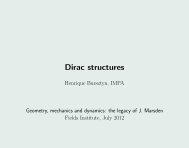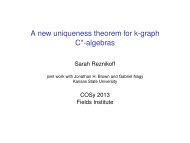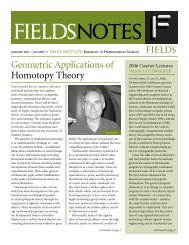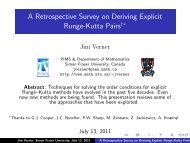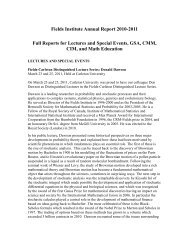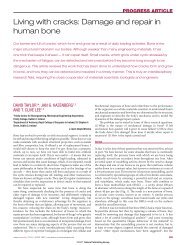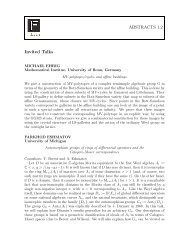SCIENTIFIC ACTIVITIES - Fields Institute - University of Toronto
SCIENTIFIC ACTIVITIES - Fields Institute - University of Toronto
SCIENTIFIC ACTIVITIES - Fields Institute - University of Toronto
You also want an ePaper? Increase the reach of your titles
YUMPU automatically turns print PDFs into web optimized ePapers that Google loves.
Directed Polymers and Random Growth<br />
JEREMY QUASTEL IS PROFESSOR AND ASSOCIATE CHAIR OF<br />
mathematics at the <strong>University</strong> <strong>of</strong> <strong>Toronto</strong>. He was one <strong>of</strong> the delegates<br />
representing Canada at the International Congress for Mathematicians in<br />
Hyderabad this year (where he presented his work in Section 13: Probability<br />
and Statistics) and is co-organizer <strong>of</strong> the Thematic Program on Dynamics and<br />
Transport in Disordered Systems starting January 2011 at the <strong>Fields</strong> <strong>Institute</strong>.<br />
His talk at the <strong>Fields</strong> <strong>Institute</strong>’s 2010 Annual General Meeting was<br />
titled Directed polymers and random growth, a topic <strong>of</strong> probability theory and<br />
stochastic differential equations. He spoke <strong>of</strong> the relationship between the<br />
process <strong>of</strong> ballistic aggregation and discrete and continuum directed random<br />
polymer models.<br />
What does a random surface look like after a long period <strong>of</strong> time?<br />
Ballistic aggregation is meant to answer this question, a discrete model in<br />
one-dimension for blocks falling and building up on the 1D integer lattice.<br />
The relevance <strong>of</strong> this theory to science is that understanding this process will<br />
allow engineers to develop new tools to build materials by spraying atoms onto<br />
a surface. Understanding <strong>of</strong> this and analogous models are one <strong>of</strong> the central<br />
themes Quastel would like to see develop in his thematic program. He reports<br />
that there have been a number <strong>of</strong> significant advances in the study <strong>of</strong> these<br />
models and will certainly add excitement to the activity at <strong>Fields</strong> next year.<br />
His lecture was split into two parts, background and recent results. The<br />
directed random polymer models about which Quastel spoke were in the 2D<br />
randomly weighted integer lattice. Each point in the lattice is represented by<br />
W with an imposed random walk X that goes through the lattice collecting<br />
i , j<br />
i<br />
the random values W and sums up the values. Taking the expectation<br />
i , j<br />
(summing all the possible paths and taking the logarithm <strong>of</strong> the sum) gives<br />
us the free energy on the lattice. Physicists predict that the free energies <strong>of</strong><br />
the discrete random polymer model will give valuable information about the<br />
object.<br />
Quastel spoke about some reformulation <strong>of</strong> the GUE Tracy-Widom<br />
models from random matrix theory in terms <strong>of</strong> the rescaled distribution <strong>of</strong> the<br />
principle eigenvalue <strong>of</strong> a randomly chosen matrix from the GUE-TW. To his<br />
surprise, these results are useful for the continuum directed polymer models.<br />
In the context <strong>of</strong> the discrete model, Quastel mentioned his interest in<br />
the behaviour emering from the strong coupling between the random walks<br />
and the random lattice. The KPZ (Kardar-Parisi-Zhang) model governs<br />
anything that experiences growth governed by randomness at different<br />
sites, with added non-linearity. These models are extremely general. Quastel<br />
mentioned his interest in having the theoretical tools to make robust<br />
predictions over the KPZ universality class. In models studied in the past, as<br />
the dimension increases, randomness behaviour undergoes a phase transition<br />
1<br />
3<br />
where the n and Tracy-Widom distributions are replaced with normal<br />
Gaussian behaviour and random walks.<br />
The results obtained in work done with Gideon Amir and Ivan Corwin<br />
are contained in a recent paper concerning the continuum directed random<br />
polymer. The paper contains all the necessary formulas to construct a<br />
distribution for the model. Quastel stated some results about solutions that<br />
locally look like Brownian Motion, which start with smooth initial conditions.<br />
Motivation for this problem comes from results in the field <strong>of</strong> liquid crystal<br />
turbulence in which experiments were carried out in December 2009.<br />
‘Jeremy Quastel’ continued on page 20<br />
LECTURES<br />
FIELDS INSTITUTE Research in Mathematical Sciences | FIELDSNOTES 13



